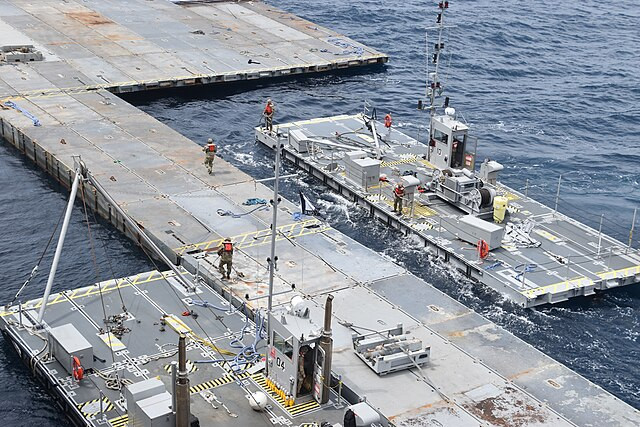A temporary pier constructed by the U.S. military to facilitate the delivery of humanitarian aid to Gaza has been severely damaged by rough seas, significantly hindering relief efforts in the region. The Joint Logistics Over-the-Shore (JLOTS) pier, announced by President Joe Biden in March and costing approximately $320 million, was intended to bypass land routes controlled by Israel and ensure the swift delivery of aid to the besieged area. However, the structure, operational for just a short period, has faced numerous challenges that have stalled its mission.
The Pentagon confirmed on Tuesday that three of the four vessels associated with the pier had run aground due to severe weather conditions. Efforts are now underway to remove the damaged pier from its anchored position on the coast and initiate repairs. This development has temporarily halted the humanitarian aid deliveries that had begun to flow through the port.
The JLOTS pier, strategically located southwest of Gaza City, was designed to handle up to 150 truckloads of aid daily once fully operational. Despite its potential, the project has been marred by logistical issues, security threats, and now, weather-related damages. The initial phase of construction, which began in late April, coincided with the region's windstorm season, leading to interruptions and delays.
Timeline of Key Events
- March 7: President Biden announces the construction of the temporary pier to support humanitarian efforts in Gaza.
- April 25: Construction begins, with the floating pier and causeway under development.
- May 1: The Pentagon reports that more than 50% of the construction is complete.
- May 2: Construction is paused due to adverse weather conditions.
- May 17: The pier is anchored, and aid deliveries commence.
- May 18: Trucks delivering aid are intercepted by desperate Gazans, halting the operation temporarily.
- May 23: Aid transfer resumes, but logistical challenges persist.
- May 25: Rough seas cause significant damage to the pier, necessitating removal and repairs.
Despite these efforts, the pier has only managed to deliver a fraction of the aid needed by the population in Gaza. The Pentagon has estimated that around 1.2 million pounds of aid have been moved to a beach transfer point, with two-thirds of that distributed further into Gaza by the United Nations.
Challenges and Setbacks
The project faced immediate challenges upon its announcement, including transferring aid from ships to trucks, security threats from potential militant attacks, and a shortage of fuel for transportation due to the Israeli blockade. Additionally, the weather has been a persistent adversary, with the initial construction coinciding with windstorm season, and subsequent operations disrupted by rough seas.
Photographs released by the South Korean military showed inflated balloons anchored with plastic bags full of garbage, highlighting the difficulties in maintaining a functional humanitarian supply line under such conditions. Pentagon spokeswoman Sabrina Singh acknowledged that the weather conditions had not been favorable but expressed confidence in the pier's eventual re-operation.
The Humanitarian Impact
The pier was never intended to replace land crossings but to supplement them, acting as a "force multiplier" for aid delivery, according to National Security Council spokesman John Kirby. Despite this, the project has faced criticism for its high cost and limited effectiveness. Humanitarian organizations have stressed that the aid reaching Gaza is only a fraction of what is needed to meet the population's needs.
In addition to logistical and weather-related challenges, the operation has been marred by incidents of looting and violence. On May 18, eleven trucks carrying aid were intercepted by Gazans, with only five reaching their intended destination. The incident underscores the desperation and chaos on the ground, further complicating aid efforts.
Looking Forward
The damaged pier sections are being towed to the Israeli coastal city of Ashdod for repairs, which are expected to take more than a week. The U.S. military, along with the Israel Defense Forces, is working to expedite the process and resume aid deliveries as soon as possible.
Despite the setbacks, officials remain committed to the mission. Mick Mulroy, a former deputy assistant secretary of defense for the Middle East, emphasized the importance of overcoming these challenges to deliver much-needed aid to the people of Gaza. "People are in desperate need of aid, and this is one means to deliver it," he told the BBC.
The situation remains fluid, with the U.S. and its partners working tirelessly to ensure that the humanitarian needs of the Gazan population are met amidst ongoing adversity. The resilience of the aid workers and the strategic importance of the JLOTS pier highlight the complex and often perilous nature of delivering humanitarian aid in conflict zones.






